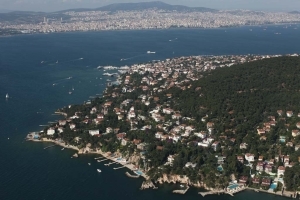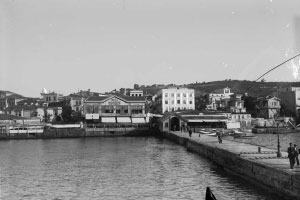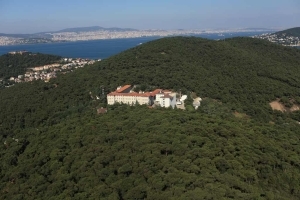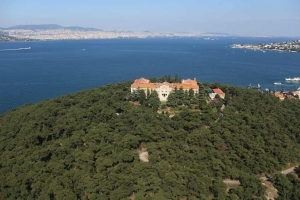English
Büyükada - Luna Park Meydanı
- Details
- Created on 05 April 2013
- Last Updated on 11 April 2013
The Monastery of St. Nicholas
 The monastery of St. Nicholas (Hagios Nikolaos) is on the eastern shore of the island, accessible by both the shore road and another road leading from the meydan below the summit of Yüce Tepe. The monastery is on or near the site of the Byzantine settlement of Karyes, which was abandoned in the seventeenth century after being devastated in a fire. The earliest mention of the monastery is by the English traveller Thomas Smith in 1680. The original katholikon of the monastery may have been built on and from the ruins of the parish church of Karyes. In 1783 the monastery temporarily housed a "School for Greek Classes," which subsequently was relocated near the Patriarchate in Istanbul as the Megale Scole, or Great School, which is still in existence.
The monastery of St. Nicholas (Hagios Nikolaos) is on the eastern shore of the island, accessible by both the shore road and another road leading from the meydan below the summit of Yüce Tepe. The monastery is on or near the site of the Byzantine settlement of Karyes, which was abandoned in the seventeenth century after being devastated in a fire. The earliest mention of the monastery is by the English traveller Thomas Smith in 1680. The original katholikon of the monastery may have been built on and from the ruins of the parish church of Karyes. In 1783 the monastery temporarily housed a "School for Greek Classes," which subsequently was relocated near the Patriarchate in Istanbul as the Megale Scole, or Great School, which is still in existence.
When the Greek War of Independence began in 1821 the monastery was taken over by the Turkish Army. Later it was restored and served to accommodate Greek families from Istanbul on visits to Prinkipo. A fire in 1852 destroyed the interior of the katholikon, including the iconostasis and most of the icons. The church was rebuilt in 1860 according to the original design, a domed four-columned cross-in-square, the plan of virtually all Constantinople churches of the medieval Byzantine era. The supposition is that the original katholikon preserved the plan of the parish church of Karyes, which is believed to have dated from the Byzantine period. The attractive narthex, covered with a tiled roof, dates to 1873. Over the entrance there is a marble relief of a double-headed eagle, emblem of the Palaeologus dynasty, who ruled Byzantium during its last two centuries. On the exterior at the northwest corner there is an ancient Greek relief representing a chariot race.
Büyükada - Important Villas and Mansion Houses You Can Encounter During Short Tour And Grand Tour Which You Can Do With A Coach Or Bicycle
- Details
- Created on 05 April 2013
- Last Updated on 11 April 2013
 The street on the left side of the square leads to Fayton Meydanı, where all the horse-drawn carriages wait to be hired. The standard routes for visitors are the Büyük Tür (Grand Tour), a complete circuit of Büyükada, and the Küçük Tür (Short Tour), which does only the northern half, cutting across the waist of the island between Isa Tepesi and Yüce Tepe.
The street on the left side of the square leads to Fayton Meydanı, where all the horse-drawn carriages wait to be hired. The standard routes for visitors are the Büyük Tür (Grand Tour), a complete circuit of Büyükada, and the Küçük Tür (Short Tour), which does only the northern half, cutting across the waist of the island between Isa Tepesi and Yüce Tepe.
Büyükada - Center
- Details
- Created on 18 February 2013
- Last Updated on 11 April 2013
The Ferry İskele
 The lead-domed terminal building of the regular ferry, distinguished by its octagonal passenger hall, was designed in 1899 by the architect Mihran Azaryan of Izmit and completed in 1915. The tile revetment was made by Mehmet Emin Efendi of Kütahya. The upper floor was used as a cafe in the years 1918-23; from 1923-50 it was the District Office of the Republican Party’s Adalar (Islands) branch; in 1950-51 it housed the island’s first indoor cinema. The building was restored in 1999-2000, when Çelik Gülersoy of the Turkish Touring and Automobile Club created an elegant cafe on the upper floor, with a large balcony commanding a view of the Asian shore of the Marmara, an ideal spot to take refreshments before or after touring the island.
The lead-domed terminal building of the regular ferry, distinguished by its octagonal passenger hall, was designed in 1899 by the architect Mihran Azaryan of Izmit and completed in 1915. The tile revetment was made by Mehmet Emin Efendi of Kütahya. The upper floor was used as a cafe in the years 1918-23; from 1923-50 it was the District Office of the Republican Party’s Adalar (Islands) branch; in 1950-51 it housed the island’s first indoor cinema. The building was restored in 1999-2000, when Çelik Gülersoy of the Turkish Touring and Automobile Club created an elegant cafe on the upper floor, with a large balcony commanding a view of the Asian shore of the Marmara, an ideal spot to take refreshments before or after touring the island.
Heybeliada - Tour Trough the Woods, Monasteries and Çam Limanı
- Details
- Created on 11 April 2013
- Last Updated on 11 April 2013
Monastery of Hagia Triada
 In Byzantine times, there were at least three monasteries on Heybeliada, then known as Halki. The most renowned of these was Hagia Triada, the Holy Trinity, whose site on Ümit Tepesi is occupied by the Greek Orthodox theological school of the same name, a direct descendant of the original Byzantine monastery. The present monastery is the most prominent monument on Heybeliada, dominating the view from an approaching ferry and from within the village itself.
In Byzantine times, there were at least three monasteries on Heybeliada, then known as Halki. The most renowned of these was Hagia Triada, the Holy Trinity, whose site on Ümit Tepesi is occupied by the Greek Orthodox theological school of the same name, a direct descendant of the original Byzantine monastery. The present monastery is the most prominent monument on Heybeliada, dominating the view from an approaching ferry and from within the village itself.
The earliest reference to a monastery on Halki is in the writings of St. Theodore of Studius early in the ninth century. Theodore, abbot of Constantinople’s famous monastery of St. John of Studius, was exiled to a monastery on Halki by Leo V (r. 813-20) because of his criticism of the emperor’s iconoclastic policy. While on Halki, Theodore wrote a number of letters, theological treatises, and poems, one of which was addressed fondly to the monastic cell in which he was confined.
The monastery of the Holy Trinity was restored by the patriarch Photius I (r. 858-67, 877-86), who was twice exiled there, first between his two terms as patriarch and then in the years 887-90. Photius died in the monastery in 890 and was buried there; he was subsequently canonized and is today revered as the patron saint of the Theological School of the Holy Trinity.
The monastery was apparently destroyed at the time of the Turkish Conquest in 1453, moving one anonymous chronicler to lament the loss of what "had earlier been a place where wisdom and knowledge were studied, not only by monks but also by kings and noblemen." In 1550 the monastery was rebuilt or at least partially restored by the future patriarch Metrophanes III (r. 1565-72, 1579-80). Metrophanes also gave to the monastery some three hundred manuscripts, a priceless gift that formed the nucleus of what was to become one of the most renowned libraries in the Orthodox world after that of the Patriarchate in Istanbul.
 Hagia Triada went through difficult times in the seventeenth and eighteenth centuries, but its finances, at least, improved after Peter the Great, Tsar of Russia (r. 1682-1725), issued a chrysobull giving the monastery a long-term endowment. The monastery was rebuilt and refurbished in 1773 through the efforts of its energetic abbot, Samuel the Deaf. The monastery was badly damaged in 1821, at the beginning of the Greek War of Independence, when it was attacked by a mob and set on fire. The monastery was rebuilt in 1844 by Patriarch Germanos IV, who decreed in a synod that "a theological school should be built for a purpose pleasing to God and dwelt in by theology teachers, priests who wish to learn, and future priests." Wooden buildings were erected to house the classrooms, study hall, teachers’ quarters, student dormitories, refectory, infirmary, and patriarchal apartments, while a two-storey stone structure was built for the library. Then in 1891 a three-storey wing was added to house the administrative offices and new dormitories. All of these structures were seriously damaged in the great earthquake of 1894. Thus a completely new building had to be erected for the monastery, all of the funds for which were provided by the philanthropist Pavlos Skylitsis Stephanovik. The new monastery was designed by the architect Pericles Photiades, and the building was officially dedicated on 6 October 1896, the archimandrite Germanos Gregoras presiding as Rector of the Theological School.
Hagia Triada went through difficult times in the seventeenth and eighteenth centuries, but its finances, at least, improved after Peter the Great, Tsar of Russia (r. 1682-1725), issued a chrysobull giving the monastery a long-term endowment. The monastery was rebuilt and refurbished in 1773 through the efforts of its energetic abbot, Samuel the Deaf. The monastery was badly damaged in 1821, at the beginning of the Greek War of Independence, when it was attacked by a mob and set on fire. The monastery was rebuilt in 1844 by Patriarch Germanos IV, who decreed in a synod that "a theological school should be built for a purpose pleasing to God and dwelt in by theology teachers, priests who wish to learn, and future priests." Wooden buildings were erected to house the classrooms, study hall, teachers’ quarters, student dormitories, refectory, infirmary, and patriarchal apartments, while a two-storey stone structure was built for the library. Then in 1891 a three-storey wing was added to house the administrative offices and new dormitories. All of these structures were seriously damaged in the great earthquake of 1894. Thus a completely new building had to be erected for the monastery, all of the funds for which were provided by the philanthropist Pavlos Skylitsis Stephanovik. The new monastery was designed by the architect Pericles Photiades, and the building was officially dedicated on 6 October 1896, the archimandrite Germanos Gregoras presiding as Rector of the Theological School.
Read more: Heybeliada - Tour Trough the Woods, Monasteries and Çam Limanı
More Articles...
- Heybeliada - Center
- Burgazada - Beyond the Center
- Burgazada - Center
- Kınalıada
- Sedefadası - Antirovithos
- Museums, Cultural Centers
- Boat Tours
- Excursions and Tours
- Nightlife
- Beaches
- Bathing Water Analysis
- BÜYÜKADA - IN FRONT OF YÖRÜKALİ BEACH
- BÜYÜKADA - IN FRONT OF WATER SPORTS CLUB
- BÜYÜKADA - IN FRONT OF SEFEROĞLU FACILITIES
- BÜYÜKADA - IN FRONT OF NAKİBEY BEACH
- HEYBELİADA - IN FRONT OF WATER SPORTS CLUB
- HEYBELİADA - IN FRONT OF SADIKBEY BEACH
- BURGAZADA - IN FRONT OF WATER SPORTS CLUB
- KINALIADA - RIGHT SIDE OF PIER
- KINALIADA - LEFT SIDE OF PIER
- KINALIADA - IN FRONT OF WATER SPORTS CLUB
- KINALIADA - IN FRONT OF ÜLKER RESTAURANT
- İstanbul Long Term Average Precipitation
- İstanbul Long Term Average Sunshine Durations
- İstanbul Long Term Average Temperatures
- Age Distribution of the Population
- Hometown of the Islanders
- Population Statistics
- Distibution of the Population among the Islands
Subcategories
- Home
- Princes’ Islands
- History
- Practical İnformation
- Where To Stay
- Restaurants
- What To See
- What To Do
- F.A.Q
- Academic
-
Statistics
In this section you can find statistics collected from several offical resources.
Bathing water analysis / quality, sea temperatures, weather statistics, population and demographic statistics of the Pricess' Islands can be found here.
-
Bathing Water Analysis
This section is composed of bathing water snalysis results from measurements around the islands. These measurements are carried out around the four islands, in front of the 11 beaches during the summer season.
- Sea Temperatures
- Weather Reports
- Population and Demographics
-
Bathing Water Analysis



